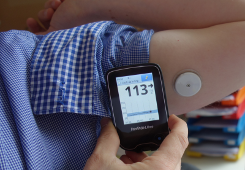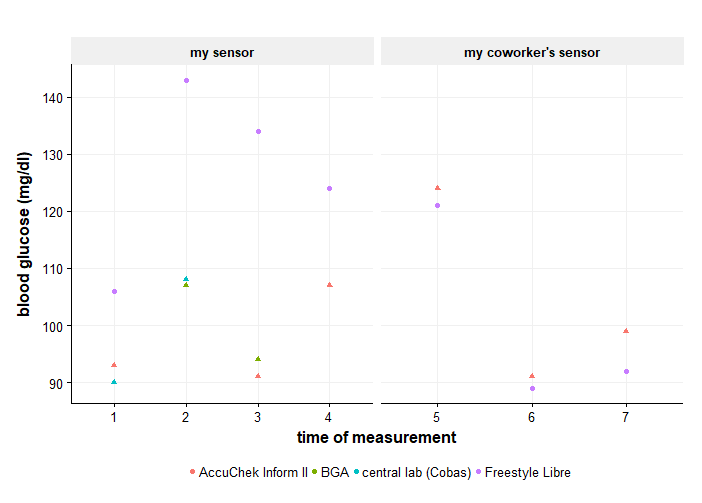Bright and dark sides of Abbott's FreeStyle Libre

(Dislaimer: The following concerns an old version of the FreeStyle Libre)
Last month a representative of Abbott gave a FreeStyle Libre glucometer for a tryout. The Freestyle Libre consists of a small patch with a microneedle and a readout unit. The microneedle patch has to be applied with a special device and lasts for up to 14 days. Therefore frequent, often painful drawing of capillary blood from the fingertip can be avoided. This concept proved so popular, that the FreeStyle Libre was sold out in Germany shortly after introduction. Some health insurances reimburse this device for type I diabetic patients, even though this is not mandatory in Germany.
The readout unit displays the result clearly. An arrow indicates the direction of change since the last measurement. Past values are also depicted as a small graph. The touchscreen allows for easy navigation to access for example last day’s values.
I compared measurements from the Freestyle Libre with measurements from the AccuChek Inform II that we use in my hospital Klinikum Rechts der Isar and was surprised by the large deviations. Therefore I performed additional comparisons with measurements in our central laboratory (Roche Cobas c 701 ) and with measurements from our blood gas analyzer (Siemens RAPIDLab 1200). While all routine measurements agreed quite well, the Freestyle Libre measured higher by up to 40 mg/dl. A college of mine also tried out the FreeStyle Libre glucometer and allowed me to compare his measurements as well. His FreeStyle measurements agreed with the Accu-Chek measurements much better. So was my sensor faulty? Lot-to-lot variations are a well-known problem with POCT test (eg. Freckmann 2015). These are of course anecdotical findings.

Abbott provides some information in its Operator’s Manual. They report a comparison of Freestyle Libre measurements with venous blood glucose measurements performed with a Yellow Spring Instrument Life Sciences 2300 STAT Plus™ Glucose & Lactate Analyzer. 1.5% of results diverge by more than 40 mg/dl. So results similar to mine are not common but not unheard of. The reported study was conducted at 4 centers with 72 participants and three lots of sensors. Larger, scientific studies are urgently needed. Nevertheless, the possibility to measure blood glucose concentration very frequently might at least theoretically compensate for a lack of precision. Clinical protocols need to be developed that make full use of these frequent measurements.
Drawing a conclusion, the Abbott FreeStyle Libre is so comfortable to wear and so easy to use that it can very likely improve the everyday life of diabetic patients. Larger studies are needed to evaluate measurement performance. To avoid faulty lots ways to better control the quality of the sensors should be developed.
